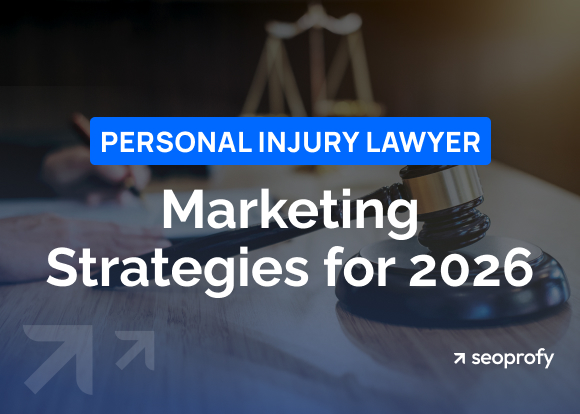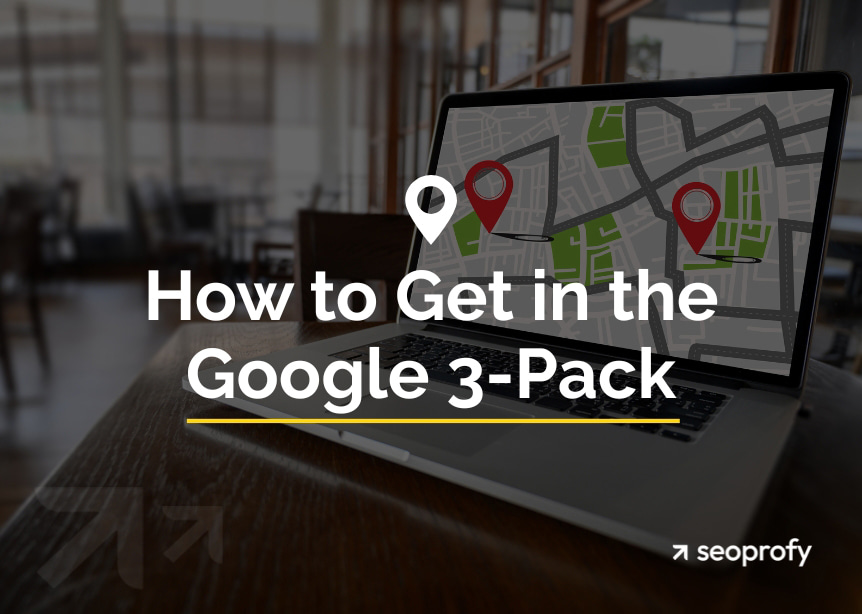Do you want to skyrocket your website traffic to hit your business goals but don’t know where to begin? The best way forward is to create an SEO strategy to set a clear path towards the top rankings!
But what should you consider while planning your site’s journey through the deep search engine jungles? In our guide, we’ll explain the importance of an SEO strategy and outline its main elements. We’ll review each stage of the planning process, highlighting the most important things to consider.
- SEO strategy is a comprehensive plan developed to improve your website’s ranking in search engine results pages.
- Implementing an efficient SEO strategy may increase organic traffic flow, solidify your online authority, strengthen your backlink profile, and even boost sales.
- The creation of high-quality, engaging, unique, and valuable content enhanced with target keywords and visual materials must be the priority of your SEO plan.
- Google primarily uses the mobile version of a website for indexing and crawling, so it should meet the Core Web Vitals criteria.
- The monitoring of the latest SEO trends and best practices is important for timely and efficient strategy adjustment.
What Is an SEO Strategy?
Before you learn how to create an SEO strategy, you need to understand what it is and what it entails. This is a process of planning a website’s content posting, keyword research, competitor analysis, link building, and on-page optimization to improve the likelihood of appearing high in search results. The successful implementation of an efficient strategy allows you to gain more search engine traffic, significantly boosting your sales and authority.
With a clear roadmap, you’ll always know what you should do next and how to handle potential problems. Further, while estimating the possible issues, you may notice the valuable possibilities to improve your business, such as new outreach opportunities. Also, the planning stage allows you to perform better target audience research so you can ensure that your content remains interesting for both real-life users and search algorithms.
Finally, your SEO strategy must be aligned with the latest Google requirements and recommendations. Considering that they change from time to time, it’s important to keep an eye on the updates and adapt your plans accordingly.
Why Is an SEO Strategy Really Important?
Before you start search engine optimization of your website, you’ll undoubtedly ask yourself a reasonable question: “Is SEO worth it?” Of course, no one wants to spend their money for nothing, so making sure you truly need to improve your website should be your number one priority.
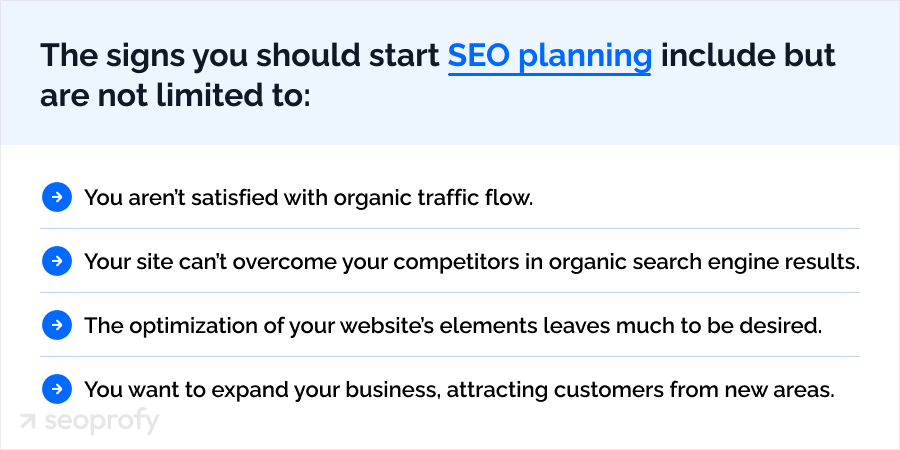
The right SEO strategy for a website can help you solve those issues. Further, it’ll prevent you from the chaos caused by inefficient resource management, uncontrolled working processes, and making your competitors’ mistakes. Regardless of your industry, the role of SEO strategy must be indispensable in your global business plan, as winning rankings won’t just increase your online authority but also boost your sales.
At SeoProfy, we believe that a personal approach to each client and custom strategies can lead to results that overcome all expectations! You’re welcome to check this SEO case in a highly competitive niche, where our team managed to accelerate organic traffic from 1,200 to 4,000 per day in 12 months.
13 Steps to Create Your Perfect SEO Strategy
Grab your coffee and a notebook because right now, you’ll discover how to create an SEO strategy that will lead your business to success. Follow the steps provided below to make your site flourish, attract potential customers, and handle potential issues.
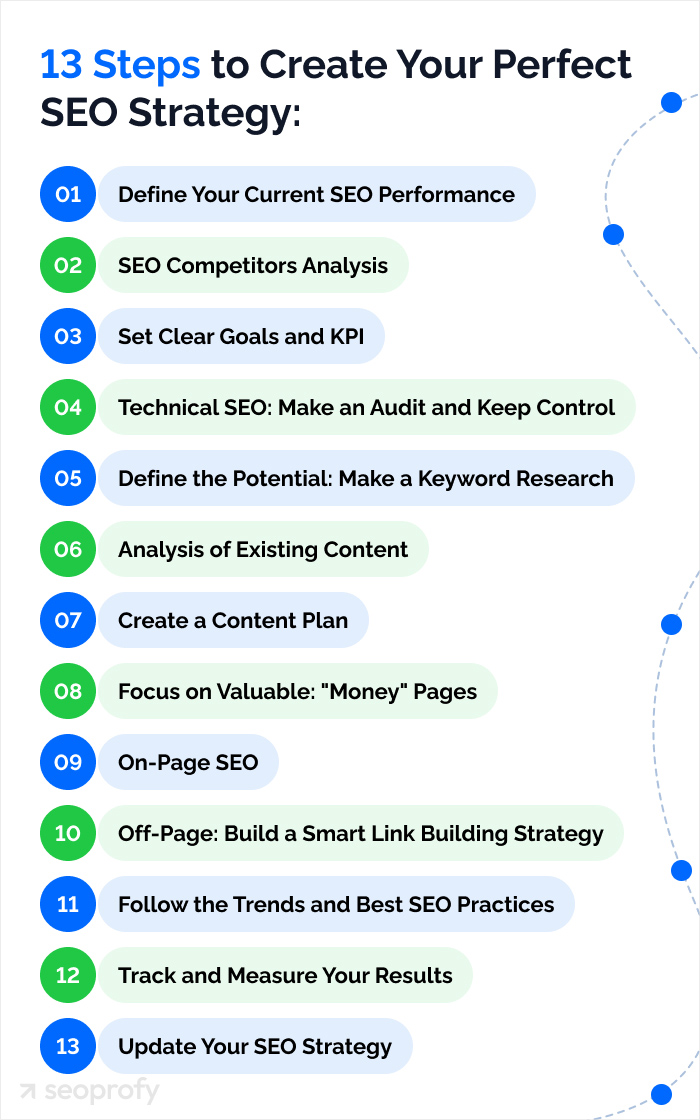
1. Define Your Current SEO Performance
Reviewing your website’s current performance is essential if you want to set clear goals and expectations from the upcoming updates. This should be the starting point of the whole optimization process. Plus, if you already have run a site, you can also identify what works and what doesn’t in your specific case. Using this information, you can start developing an effective SEO strategy.
We strongly recommend you analyze the following metrics:
- Organic traffic: This is the number of users who visit your site from unpaid search results. There are several ways to check this metric, and the easiest of them is to opt for the best tools for SEO, including Ahrefs and Google Analytics.
- Keyword rankings: This metric shows your site’s position in organic search results for relevant keywords. Simply put, this is how high your pages appear on Google. You can analyze your keyword rankings using Semrush or Ahrefs.
- Backlinks: When your website gets links from reputable online sources related to your niche, its authority rises in the “eyes” of search engines. Consequently, they start ranking your pages higher. If you want to analyze your backlink profile, Ahrefs, Majestic, or Semrush will do the job.
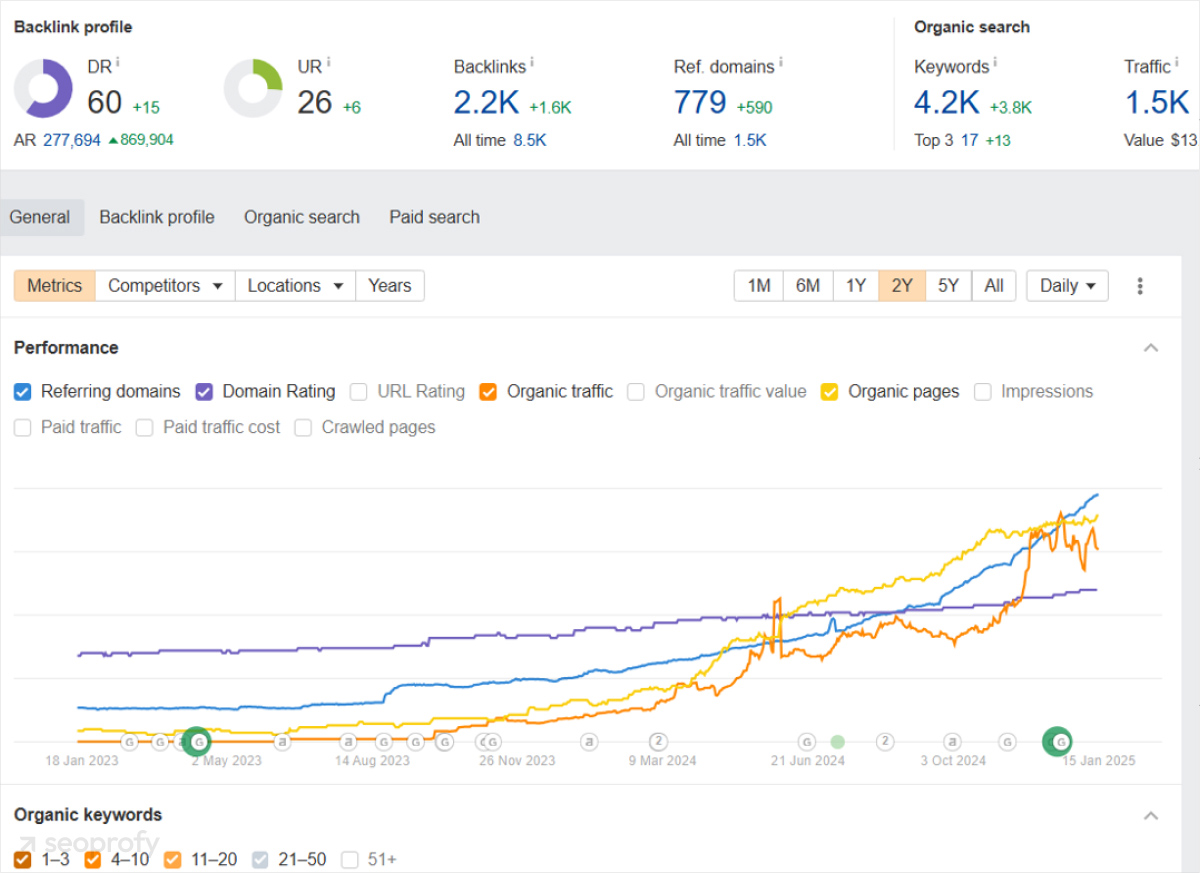
The review of these metrics will provide you with a bigger picture of your site’s overall performance. You’ll likely discover the main problems that prevent your website from the stable growth of its search engine rankings. Using this information, you can more accurately plan your SEO strategy to ensure a smooth workflow during its implementation.
2. SEO Competitors Analysis
Regardless of whether you run a small business or a big enterprise, you’ll surely have competitors, so you should also pay attention to their SEO strategies. Thus, you can identify a lot of important information, including:
- Type of content to create
- Keywords to target
- Сategories to include on your website
- Online resources to get backlinks from
All in all, you’ll understand what practices can lure your target audience and meet their search queries to make your website rank higher. Additionally, you’ll identify your competitors’ weaknesses to surpass them.
So, how can you deal with this important step? Simply follow our tips to efficiently handle all the tasks during this stage:
- Identify your competitors: First of all, you have to find out whom you compete against to gain the target audience’s attention and rankings in search engines. You can identify your main SEO competitors for desired keywords in organic search using Ahrefs. All you’ll need to do is enter your domain name, and the platforms will show the lists of possible competitors. Choose the first 10 closely relevant to your specific niche. After that, pay attention to important metrics, including traffic, keywords, and domain rating (DR), which you can review in the “Organic competitors” tab:
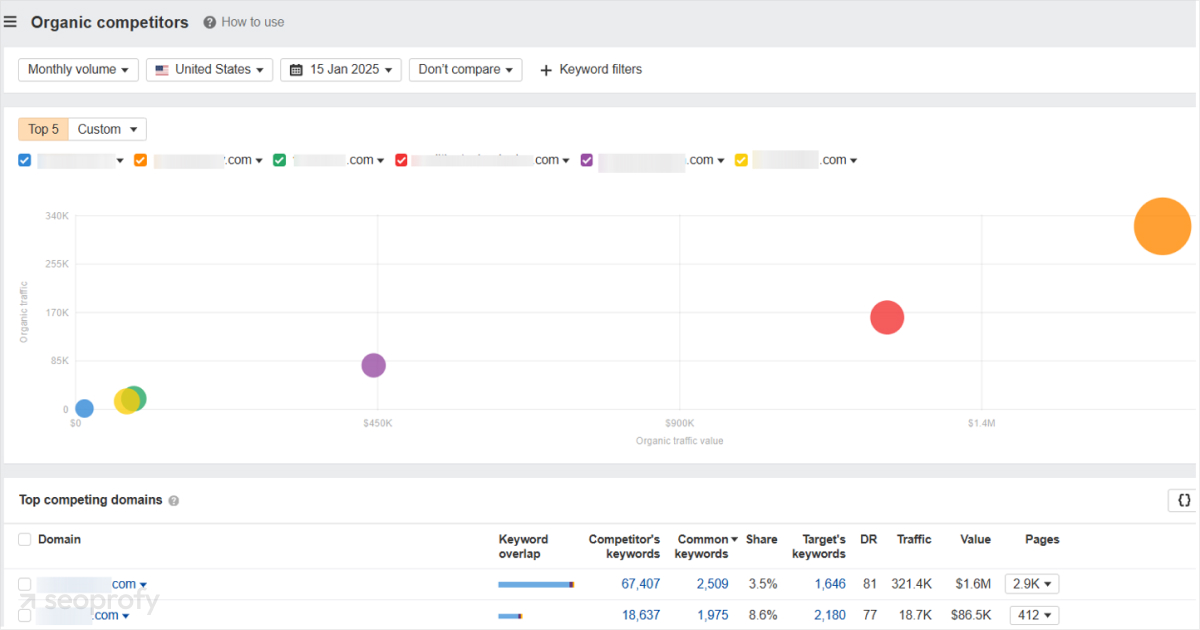
- Check the keywords: Identifying your competitors also allows you to discover valuable keywords you might have missed. You can access more opportunities to attract traffic in the following stages of your SEO strategy. For example, using Ahref’s “Competitive Analysis” feature, you can find the keywords you don’t rank for but all your competitors do.
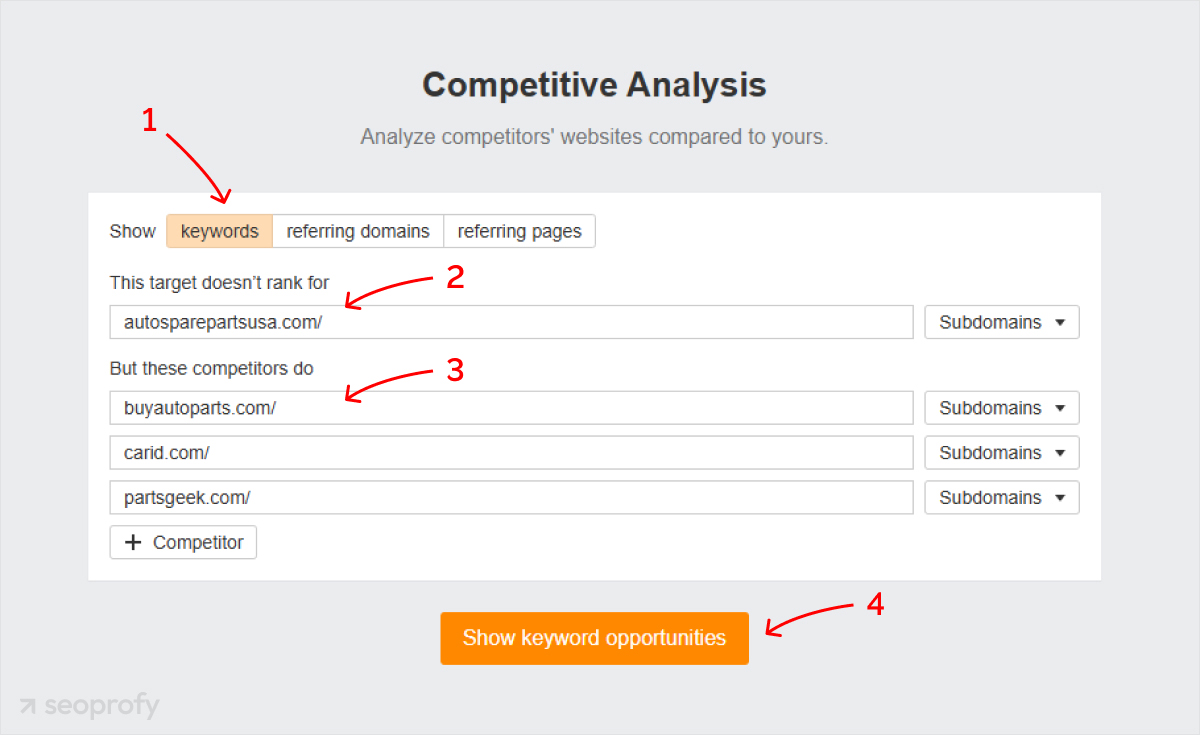
- Audit backlinks: Sites that link to your competitors may also provide you with valuable backlinks, especially if you create unique and interesting content. The good news is that platforms like Ahrefs and Semrush allow you not only to get the list of prospective outreach opportunities but also to estimate these website’s authority. Due to this, you can choose the online resources that will truly contribute to your backlink profile growth instead of affecting it with spammy links.
Finally, don’t forget that your competitors may change their strategies, opt for new keywords, or try new tactics. That’s why you should keep an eye on them and analyze their websites from time to time to learn from their experience.
3. Set Clear Goals and KPI
You can’t control the implementation of your SEO marketing strategy without clearly set expectations. Luckily, using the information you’ve already collected, you can define the goals and KPIs, which will help you measure the results of your efforts. If you see that those goals are unattainable at the moment or with the resources you have at hand, it may be a signal to change your approach to search engine optimization and review the chosen methods.
It might not be so easy to set realistic expectations, but if you want to deal with this task, we recommend you to use the SMART system, which means your goals should be:
- Specific: Decide what exactly you want to achieve after the implementation of your SEO strategy.
- Measurable: Define criteria you’ll use to estimate your success. It’s better to focus on KPIs like organic traffic, keyword rankings, backlinks, CTR (click-through rate), and indexing issues.
- Attainable: Make sure that the goals are realistic and that your expertise and financial capabilities allow you to achieve them.
- Relevant: Check whether the objectives you set will contribute to your business’ growth.
- Time-bound: Finally, all your goals should be bound to clear deadlines.
A great example of a SMART goal is “We need to increase our organic traffic by 20% in a year.” You can set several objectives, but there are not too many of them, so you still can achieve them. And if you want to manage all the processes more efficiently, try working in sprints and analyzing the results of each work week.
It may be a good idea to opt for SEO outsourcing services if you want to get the desired results faster and avoid common mistakes. Depending on your team’s possibilities, you may shift only a part of your tasks or the implementation of the whole strategy to remote experts. If you’re considering this option, check out our SEO pricing guide to calculate the expenses of the most efficient services for your website.
4. Technical SEO: Make an Audit and Keep Control
As an important part of your SEO strategy, technical optimization involves the improvement of your site’s elements to provide its visitors with a better user experience. Also, these enhancements will simplify finding, crawling, understanding, and indexing the web pages on your website for search engine bots. As a rule, during technical SEO, you should focus on the following issues:
- Poor mobile optimization: When it comes to indexing and crawling websites, Google primarily pays attention to their mobile versions, so it’s better to ensure there are no bugs and technical issues.
- Inappropriate site structure: Your site pages aren’t properly structured and linked together, preventing the crawlers and users from easily finding what they’re looking for on a website.
- Duplicate content: When several similar posts are available on multiple URLs, the algorithms won’t know which of them to list higher on search results. Moreover, they may opt for other web pages, lowering your website rankings.
- Unstructured data: Without schema markup, search engines won’t correctly understand the information on a page, preventing the information on it from showing on Featured Snippets.
- 404 pages: These are the error pages that a user sees when they try to find non-existent content on your site. If there are too many 404 pages, your website’s rankings may be affected.
- Unadjusted XML sitemaps: This important website element acts as a roadmap for search bots.
- Oversized HTML: It’ll take ages to download and execute the pages on your site if their HTML includes large scripts. This can lead to lower rankings and poorer user experience.
The problems mentioned significantly affect user retention, site indexation, and rankings. It’ll be a good idea to include their solution in your SEO strategy plan if you spot them using apps like Screaming Frog:
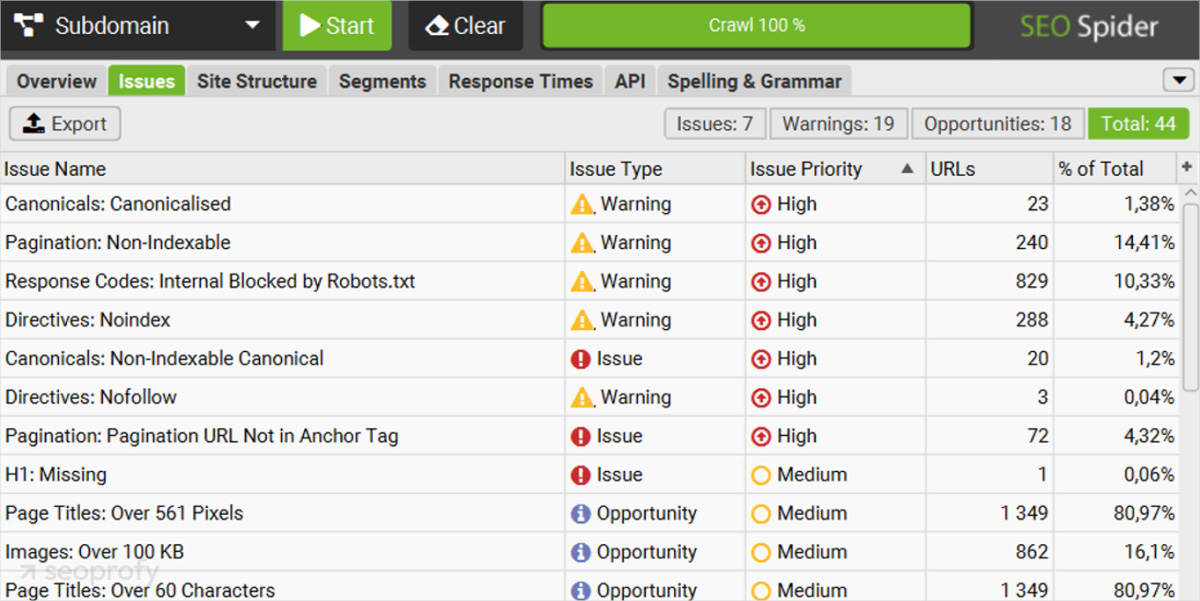
Don’t ignore the technical SEO, as this is one of the key parts of your site’s success. Check out how the enhancement of HTML structure, loading speed, and other elements led to 500% growth in car buying services in our Google Update traffic recovering case.
Don’t miss the tiniest technical issues with SeoProfy! We know how important it is to keep your website running smoothly, and our SEO company is ready to help you with this challenging task! It’s time to turn your site into a benchmark for other online businesses together with our professional services:
- Advanced technical audit
- Content quality audit
- Backlink profile audit

5. Define the Potential: Make a Keyword Research
An astonishing fact is that 15% of daily Google searches have never been searched before. (Google). This means that every day, your business gets new opportunities to be the first to reach a prospective audience. However, you will never know how to do it without proper keyword research.
It’s impossible to develop an effective SEO strategy without making content that targets the words people search for. How can you know what your target audience is interested in? Just opt for these time-tested practices to discover valuable keywords:
- Use Google Search: Despite the simplicity of this method, it’s still popular with many SEO experts. All you need to do is type the main keyword related to your business in the Google Search field. Its algorithms will automatically come up with a list of suggestions, which your prospective customers use to look for information, and it’ll look like this:
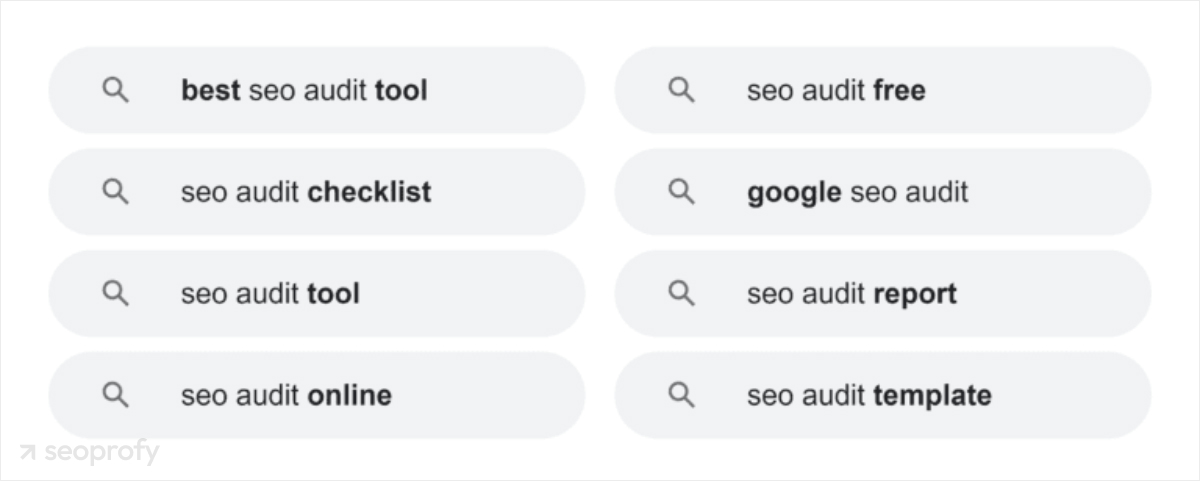
- Dive deeper into your audience’s interests and pain points: It’ll be easier to meet your clients’ search intent if you have a clear idea of their problems and interests. Furthermore, it will provide you with useful keywords and help you create content tailored to their needs, which means they’ll be more likely to read it. For example, if you run a cosmetic company and your users look for “organic skincare,” you can use this keyword to write an article, “Top 10 Reasons to Opt for Organic Skincare Products”.
- Opt for advanced SEO tools: You can always rely on platforms like Ahrefs, Semrush, and Backlinko to find keyword ideas. These tools allow you to find the options relevant to your niche and target country. Further, the advanced filters (Traffic Potential, Intent, and others) allow you to choose the most appropriate keywords and use them while implementing your SEO strategy. Check out how precisely Ahrefst allows you to review the keywords:
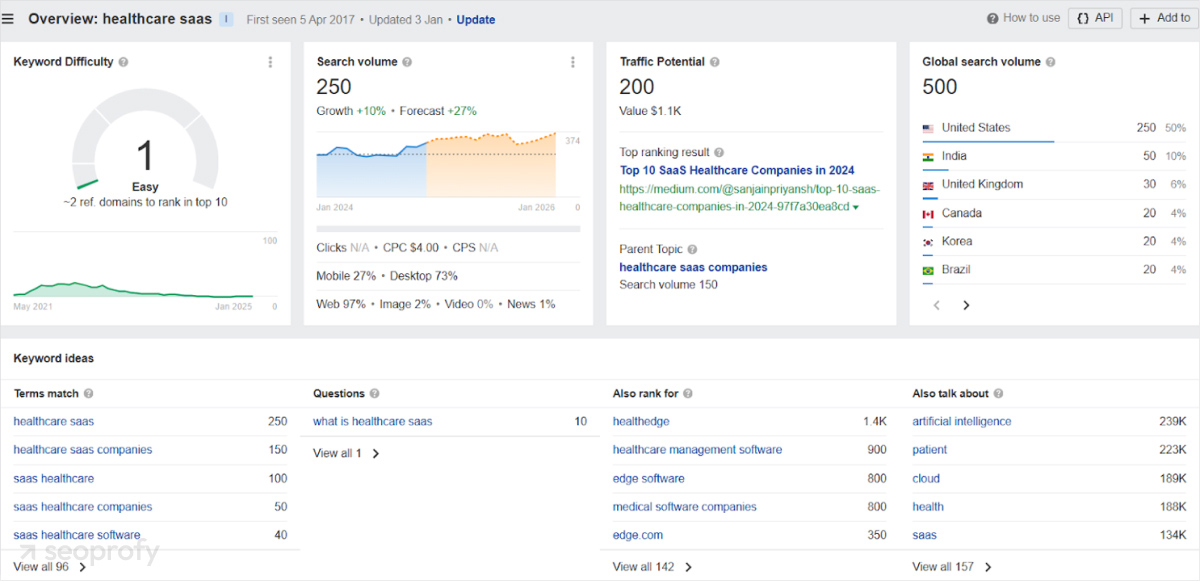
- Know the difference between keywords: We can divide the keywords into single-word phrases (e.g., “coffee”), 2-3-word phrases (e.g., “ground coffee”), and long tail keywords (e.,g. “best ground coffee in the US”). Consider that it’s easier to rank for the longer keywords, but, on the other hand, they have way lower search volumes.
6. Analysis of Existing Content
The content on your website is your chance to gain the trust of your potential customers and prove your authority. Thus, it should be interesting, valuable for your readers, and unique. While planning your SEO content strategy, reviewing your existing blog posts should be among your main priorities. The analysis allows you to discover the pages that don’t perform well and find efficient ways to improve them.
You can start your audit by identifying low-performing content. That’s where Google Analytics comes into play. Open the tool and navigate to the “Landing page” tab, which you can find in the “Engagement.” Then, use filters to sort the pages by the lowest number of sessions. Now, you can see the content that just doesn’t attract your audience, so you can decide what to do with it:
- Optimize content, making it more relevant.
- Simply remove it from your website.
- Use 301 redirects to a similar page.
- Merge content with more popular blog posts on your site.
The choice of the action depends on the content type. For instance, if you have a blog post about your company’s event that took place five years ago and wasn’t really noticeable, it may be a good idea just to delete it. At the same time, the content may be great, but the information is slightly outdated. In this case, it means that the page has traffic potential, and you may note in your SEO plan that it needs optimization and updating.
Additionally, ensure that all your posts meet the requirements of Google’s E-E-A-T criteria. Your content should be based on Experience, Expertise, Authoritativeness, and Trustworthiness. Following these principles will give you confidence that your content meets Google’s quality and relevancy standards.
You can also use Ahrefs’ Competitive Analysis tool to improve your content. For example, you can enhance your blog posts’ ranking by organically weaving the missed keywords into the existing content. You may also discover the subtopics you haven’t covered yet.
Finally, many content creators underestimate the power of Google Search Console. This free tool can stand you in good stead if you want to learn which content types and topics get the most backlinks. Enter the “Top Linked Pages” report and opt for “More.” Then, sort the pages in descending order so you can understand what type of content attracts the most links from unique websites.
7. Create a Content Plan
You should keep entertaining your audience with interesting and unique blog posts. The best way to do it regularly is to create an SEO content strategy. Here, you can find the most effective tips that will help you deal with this important task:
- Know your audience: There is no reason to publish a blog post reviewing the best wardrobes in 2025 if you run an online store that sells laptops. Posting irrelevant information may significantly affect customer retention and overall rankings on Google. On the contrary, interesting blog posts focused on the solution to your audience’s problems will attract them to your site and make them spend more time there.
- Create a content schedule: Don’t forget to come up with a well-structured content calendar when working on your SEO strategy. It’ll help you align the publication of your blog posts with seasonal trends, industry events, and holidays. You’ll never run out of ideas of what to share with your audience if you have a clear content roadmap.
- Implement the keywords: When you develop an SEO strategy and focus on your content, think beforehand about the keywords you can insert into your content. Also, keep in mind that they should be naturally woven into the text. Remember that no one likes reading sentences like: “Our acryl baths are the best acryl baths for homeowners because these best acryl baths are made of quality materials!”
8. Focus on Valuable: “Money” Pages
No doubt, an effective SEO strategy should not only lead to higher rankings but also help you generate more income. Thus, focus on so-called “money” pages, which sell your goods or services. Ideally, they should have high business value and be attractive to your target audience.
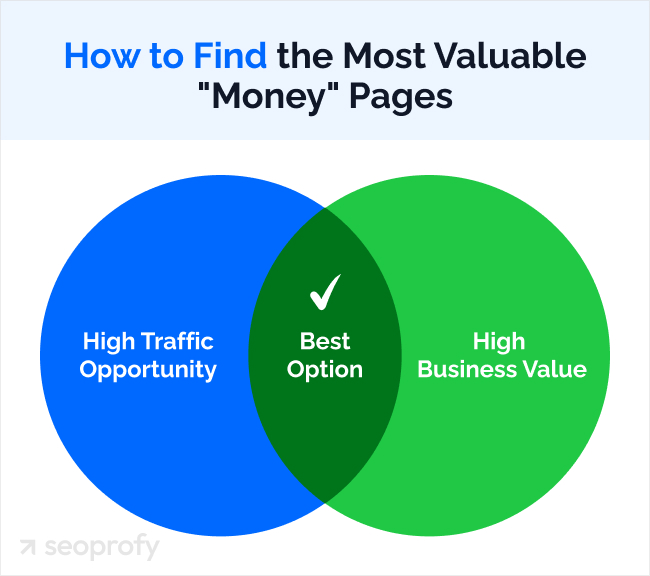
As a part of your SEO strategy, you can identify such pages using Google Analytics or Ahrefs. The latter is a preferable option if you are new to the world of SEO. Use the platform’s Site Explorer, where you should enter your domain. After that, visit the “Organic keywords” report and use filters for keyword rankings in positions from 2 to 10. Additionally, remove all informational blog posts from the report. Luckily, Ahrefs allows you to exclude the pages containing certain URLs (e.g., “/blog/”):
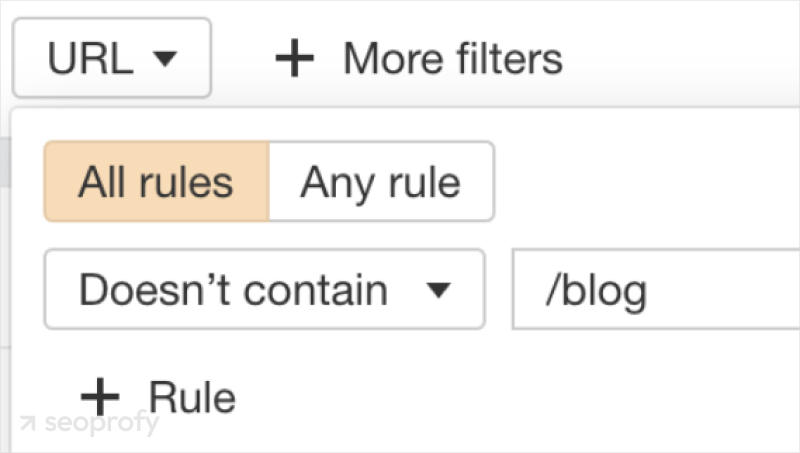
Now, look through the report and find your “money” pages there. Once you do it, open Google and enter “site:x.com + “y,” where”x ” is your website’s name and “y” stands for the topic of your “money” page. As a result, you’ll get examples of your blog posts that mention the target phrase. Now, you can use these opportunities to add the inner links to your “money” page.
You can also opt for the “Best by links” report in Ahrefs’ Site Explorer. Choose the blog posts with the most referring domains and insert the links to your “money” pages there too.
Another efficient method to boost your sales is to use the “Internal link opportunities” report in Ahrefs’ Site Audit. This is undoubtedly the easiest way, as the platform will automatically help you find the content on your websites where you can insert links to your “money” page just like it’s shown on the screenshot:

9. On-Page SEO
According to Google’s recommendations, the creation of helpful, reliable, and people-first content should be the main priority of your SEO strategy. Nonetheless, you shouldn’t forget about the importance of on-page optimization, which will have a direct influence on your visitor’s experience. Here is a checklist of website elements you should review to ensure there are no issues:
- Title tags: Ideally, the length of your SEO title tags should be between 50-60 characters. In addition, ensure that each page has its own unique and clickable title.
- Meta descriptions: They should be between 150-160 characters and up to 920 pixels in size if you want Google to display them correctly. Plus, don’t forget to include the main keywords in your meta descriptions.
- Headings: Each page must have a clear structure, which you can create using H1, H2, and H3 header tags.
- Internal links: First of all, check whether there are no broken internal links. If you find any, replace them immediately. Also, diversify anchor text and implement breadcrumb navigation.
If you want to perform a comprehensive on-page SEO audit, you may rely on Semrush. The platform offers access to the advanced checker that will provide you with a detailed report. Once you get it, pay attention to the following elements:
- Total ideas: It’ll show the number of suggested on-page optimization opportunities.
- Organic search traffic boost: The platform will also estimate how much traffic your site can gain after the improvements.
- TOP pages to optimize: As its name suggests, this element provides you with the pages that will bring you the most benefits after optimization.
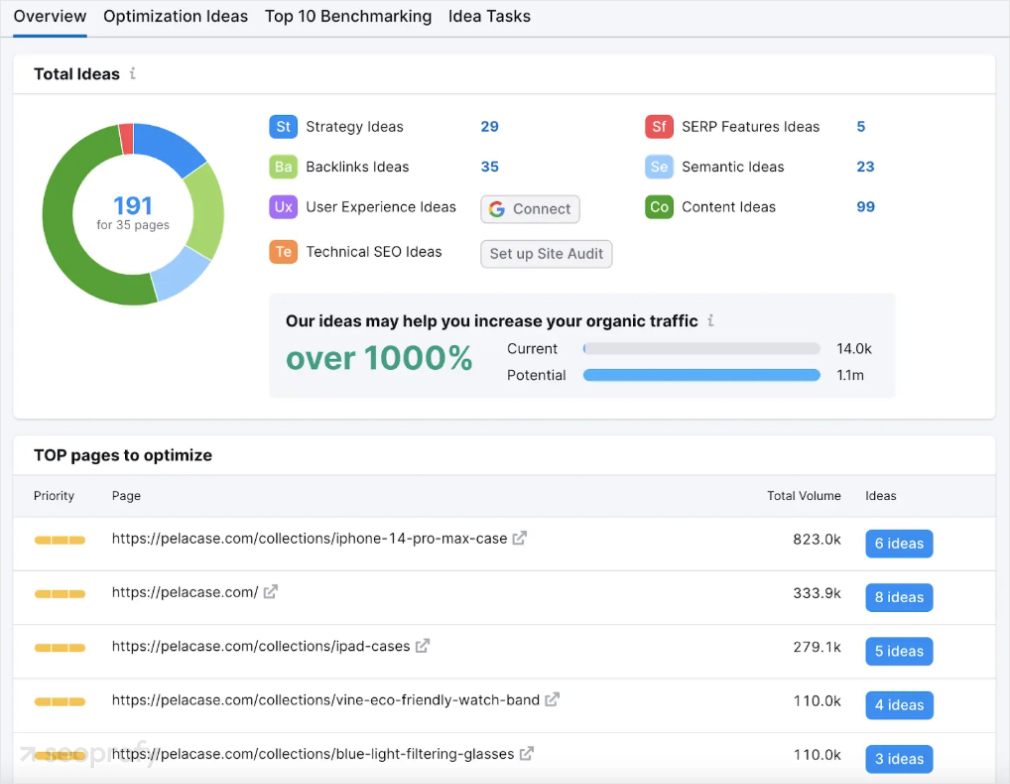
It’s also great that the platform divides its ideas into several categories. It also estimates the difficulty of each action and allows you to assign tasks to other team members directly from Semrush. Using all these advantages will surely help you create an SEO strategy that will boost your online traffic.
Do you want to develop the best strategy for SEO tailored to your specific needs and niche? Rely on SeoProfy and our extensive experience in different industries. With dozens of case studies, our team of dedicated specialists, and niche-tailored content writers, our team is here to offer you outstanding services, leading to outstanding results:
- Increased conversions
- Higher page positions in organic search
- Improved traffic
10. Off-Page: Build a Smart Link Building Strategy
Link building will be a key ranking factor in Google’s search engine algorithm in the next five years. Considering this trend, you just can’t start the improvement of your site without a proper link-building strategy, which should include:
- Work with the broken backlinks: Sometimes, a backlink may point to your page that no longer exists. In this case, it’ll be “broken,” as the user who follows it will get nowhere. As a rule, these backlinks affect your website’s reputation and rankings, so you should track them so you can remove them ASAP. Also, you may contact other webmasters, offering them to replace the broken links with new ones.
- Active brand promotion: There are many efficient off-page optimization methods, including social media, podcasts, local citations, PR submissions, etc. It’s important to find out which of them works the best for your particular niche and create an SEO strategy considering this information.
- Link quality and diversity: Getting links from any online sources is not enough. The websites referring to your content should be authoritative and relevant to your niche. Further, it’s important to ensure that backlinks come from different types of sources, such as blogs, news websites, or directories. You can keep an eye on your Backlink profile growth and diversity using platforms like Ahrefs:
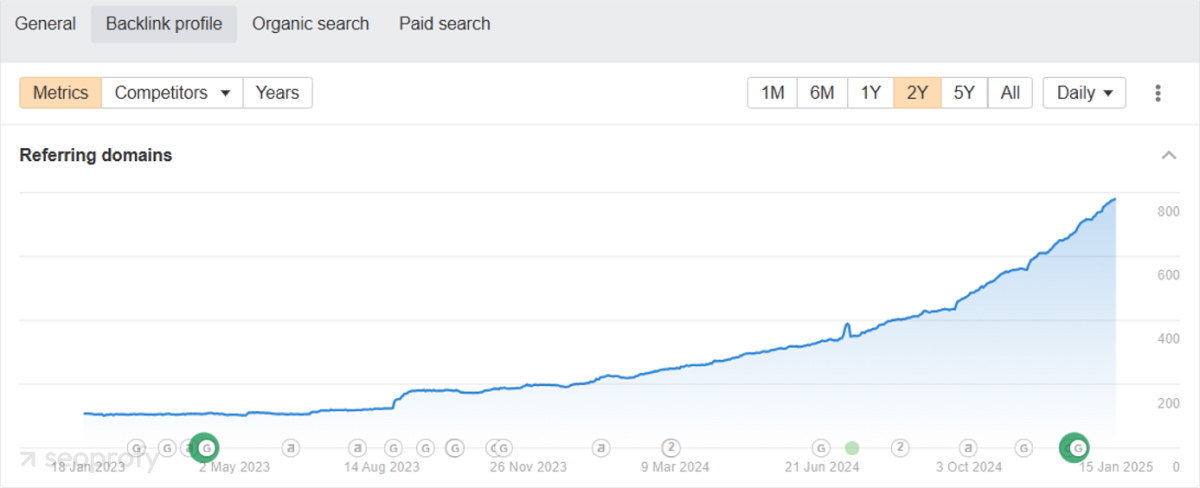
Stable growth of your backlink profile is one of the main cornerstones of your site’s success. You should always look for new possibilities to promote your website as it’s a great way not only to increase its rankings but also to reach more potential clients. At the same time, it’s not recommended to opt for black-hat techniques like link farms and PBNs.
11. Follow the Trends and Best SEO Practices
The development of an effective SEO strategy is impossible without the best practices. While some trends may lose their relevance and effectiveness, others stay relevant for years! If you want to keep your rankings in 2025, you definitely need to get acquainted with top SEO statistics collected from our most recent research. Plus, we’ve prepared a list of the practices you should certainly consider this year:
- Content is king: The creation of top-quality product descriptions and blog posts is undoubtedly the heart of all SEO practices. At the same time, it’s not enough to only focus on quality and uniqueness. If you want to attract a modern audience, you should enhance your content with helpful tips, useful case studies, and real-life examples.
- Opt for visuals: Tables and infographics can significantly enhance the perception of your content. Moreover, the pages with relevant visual elements tend to get more backlinks than those without them.
- Provide additional value: Many modern users opt for watching videos and listening to podcasts instead of reading, and you should consider this trend. For example, you can embed relevant YouTube videos into your pages and add the possibility of listening to the blog posts. Plus, from time to time, you may offer your target audience the opportunity to download useful PDF files with trend overviews, checklists, or industry reports.
- Mobile indexing: Modern search engines prioritize mobile-friendly websites. You’ll never reach high rankings if your site doesn’t meet the Core Web Vitals criteria, which include loading speed, interactivity, and visual stability. Of course, all these elements should also be optimized for people who use smartphones and other portable gadgets.
12. Track and Measure Your Results
You can’t say whether your SEO strategy is successful if you don’t track it. Without proper management, you won’t be able to spot your mistakes and fix them timely.
Ideally, you should develop systematic control over the implementation of your SEO practices. Of course, the level of management you need directly depends on your site’s size, the number of competitors, and your industry. If you run a relatively small online resource, only a few hours of maintenance each month will be enough. Use this time to focus on the result of the most essential updates and plan minor optimization tasks. Considering it, using Google Analytics is just enough to monitor essential metrics like total clicks and impressions:
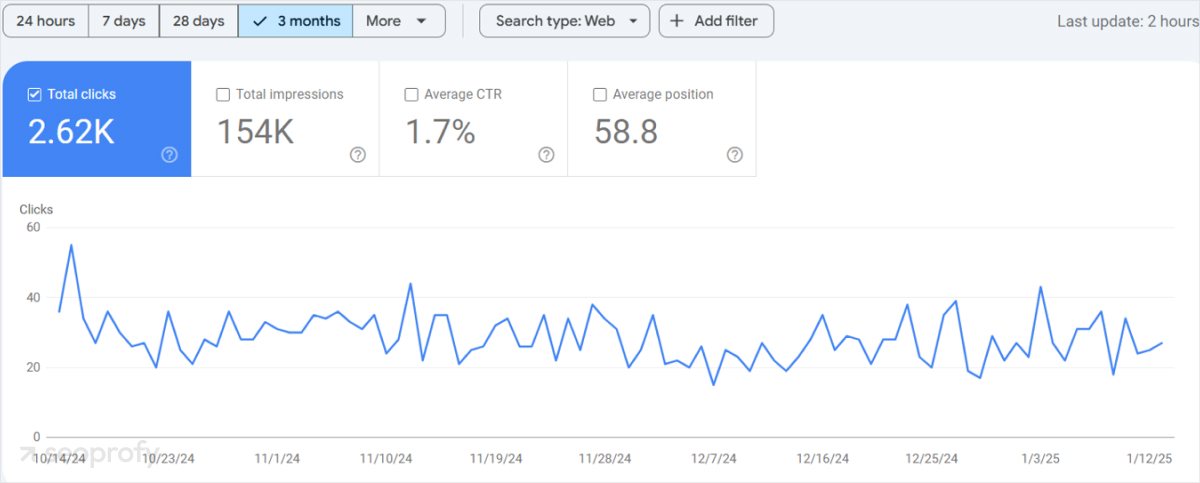
On the other hand, large websites in highly competitive industries require much more detailed maintenance to stay on top. It’s better to track and measure your performance weekly, as even the tiniest omission may ruin all your SEO efforts. Of course, you won’t be able to manage everything using only Google Analytics. You’ll need to opt for paid plans in Ahrefs, Semrush, Majestic, and other advanced tools to manage your website.
13. Update Your SEO Strategy
Even if you create an effective SEO strategy, it still needs to be reviewed later. You may want to change your approach or implement new trends. Plus, even thorough planning doesn’t prevent you from failure. If you see that your current techniques don’t provide you with the desired results, you should stop and comprehensively analyze your current strategy.
But don’t rush to change your plans if you don’t see results in a day! Search engine optimization is a complex process that may take months before you see the first results.
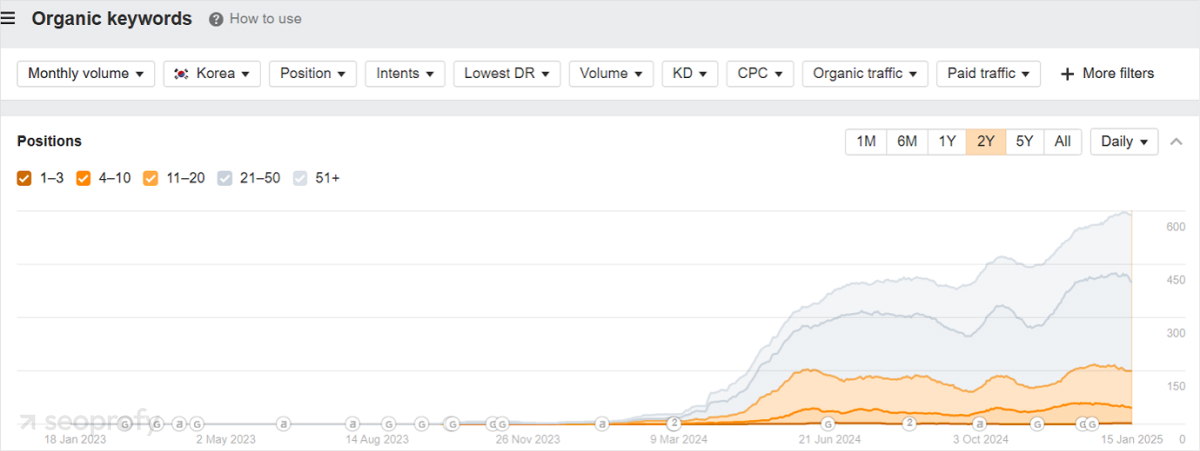
Craft high-quality content, expand your backlink profile, and fix your website’s technical issues — stay consistent in these actions, and you’ll surely be pleased with the results. If you feel stuck in the SEO labyrinth, you’re always welcome to get in touch with our team so we can guide you through all the issues.
Final Thoughts
The development of the best SEO strategy for your website may require more than a week, especially if your business operates in a highly competitive niche. Although this process may seem unnecessary at first, you’ll surely be thankful for planning everything ahead when you start the optimization process.
With clear goals and checklists, you won’t get stuck on any of the site’s improvement stages. Moreover, you’ll be able to avoid your competitors’ mistakes, which will eventually lead to higher rankings, more organic traffic, and, of course, increased sales.








